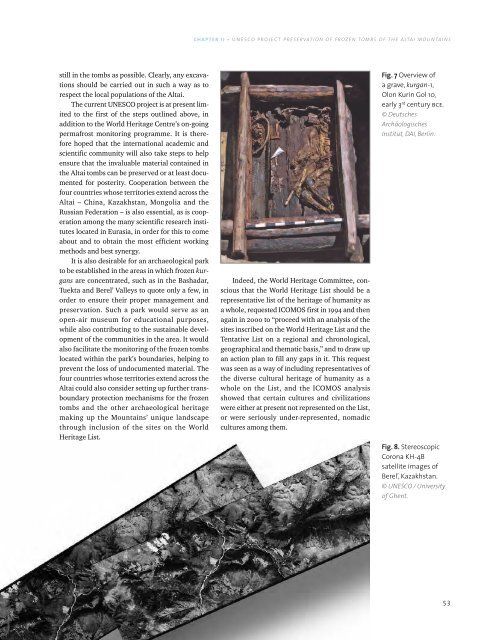Scythian Culture - Preservation of The Frozen Tombs of The Altai Mountains (UNESCO)
Create successful ePaper yourself
Turn your PDF publications into a flip-book with our unique Google optimized e-Paper software.
CHAPTER II • <strong>UNESCO</strong> PROJECT PRESERVATION OF FROZEN TOMBS OF THE ALTAI MOUNTAINS<br />
still in the tombs as possible. Clearly, any excavations<br />
should be carried out in such a way as to<br />
respect the local populations <strong>of</strong> the <strong>Altai</strong>.<br />
<strong>The</strong> current <strong>UNESCO</strong> project is at present limited<br />
to the first <strong>of</strong> the steps outlined above, in<br />
addition to the World Heritage Centre’s on-going<br />
permafrost monitoring programme. It is therefore<br />
hoped that the international academic and<br />
scientific community will also take steps to help<br />
ensure that the invaluable material contained in<br />
the <strong>Altai</strong> tombs can be preserved or at least documented<br />
for posterity. Cooperation between the<br />
four countries whose territories extend across the<br />
<strong>Altai</strong> – China, Kazakhstan, Mongolia and the<br />
Russian Federation – is also essential, as is cooperation<br />
among the many scientific research institutes<br />
located in Eurasia, in order for this to come<br />
about and to obtain the most efficient working<br />
methods and best synergy.<br />
It is also desirable for an archaeological park<br />
to be established in the areas in which frozen kurgans<br />
are concentrated, such as in the Bashadar,<br />
Tuekta and Berel’ Valleys to quote only a few, in<br />
order to ensure their proper management and<br />
preservation. Such a park would serve as an<br />
open-air museum for educational purposes,<br />
while also contributing to the sustainable development<br />
<strong>of</strong> the communities in the area. It would<br />
also facilitate the monitoring <strong>of</strong> the frozen tombs<br />
located within the park’s boundaries, helping to<br />
prevent the loss <strong>of</strong> undocumented material. <strong>The</strong><br />
four countries whose territories extend across the<br />
<strong>Altai</strong> could also consider setting up further transboundary<br />
protection mechanisms for the frozen<br />
tombs and the other archaeological heritage<br />
making up the <strong>Mountains</strong>’ unique landscape<br />
through inclusion <strong>of</strong> the sites on the World<br />
Heritage List.<br />
Indeed, the World Heritage Committee, conscious<br />
that the World Heritage List should be a<br />
representative list <strong>of</strong> the heritage <strong>of</strong> humanity as<br />
a whole, requested ICOMOS first in 1994 and then<br />
again in 2000 to “proceed with an analysis <strong>of</strong> the<br />
sites inscribed on the World Heritage List and the<br />
Tentative List on a regional and chronological,<br />
geographical and thematic basis,” and to draw up<br />
an action plan to fill any gaps in it. This request<br />
was seen as a way <strong>of</strong> including representatives <strong>of</strong><br />
the diverse cultural heritage <strong>of</strong> humanity as a<br />
whole on the List, and the ICOMOS analysis<br />
showed that certain cultures and civilizations<br />
were either at present not represented on the List,<br />
or were seriously under-represented, nomadic<br />
cultures among them.<br />
Fig. 7 Overview <strong>of</strong><br />
a grave, kurgan-1,<br />
Olon Kurin Gol 10,<br />
early 3 rd century bce.<br />
© Deutsches<br />
Archäologisches<br />
Institut, DAI, Berlin.<br />
Fig.8.Stereoscopic<br />
Corona KH-4B<br />
satellite images <strong>of</strong><br />
Berel’, Kazakhstan.<br />
© <strong>UNESCO</strong> / University<br />
<strong>of</strong> Ghent.<br />
53
















